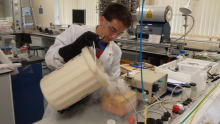
University:
Major:
Site Abroad:
Mentor(s):
Faculty Sponsor(s):
Faculty Sponsor's Department:
Project Title:
Project Description:
Nacre, a natural inorganic-organic composite found in many mollusc shells, combines high fracture toughness and strength. This combination of strength and toughness is a result of the so-called brick-and-mortar structure of aligned calcium carbonate platelets (brick) ‘held together’ by polymers (mortar). In an attempt to replicate the aligned structure of nacre in the lab, we employed freeze-casting techniques to arrange artificial alumina platelets (10-20 μm diameter), into lamellar structures. With particles of this size freeze-casting presents some unsolved challenges, including the prevention of sedimentation and the alignment of these platelets over large areas, e.g., the size of the entire sample. My project attempted to solve these problems by modifying freeze casting conditions and alumina slurry additives. Low magnification SEM images of the freeze cast samples were used to visually check for structural differences. The sedimentation problem was solved through the systematic modification of the reaction conditions creating well-dispersed and stable slurries. With such ‘modified’ slurries it was easily possible to freeze-cast lamellar and locally aligned structures. Moreover, I investigated other factors that could influence the alignment of the platelets to then achieve large-scale alignment and found that a combination of a bespoke substrate resulted in about 70% alignment of the sample. Future work will focus on further adjusting the reaction conditions in order to obtain full alignment of the platelets and with the ‘brick-phase’ in place, a variety of second phases (mortar) will then be incorporated between the lamellae to produce multifunctional, nacre-like composites.
